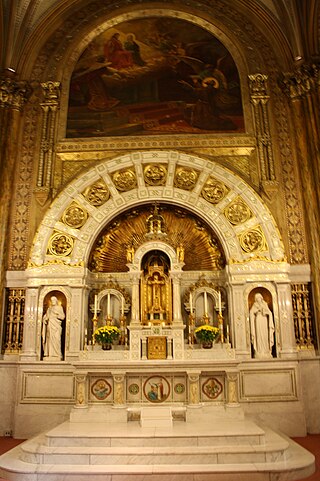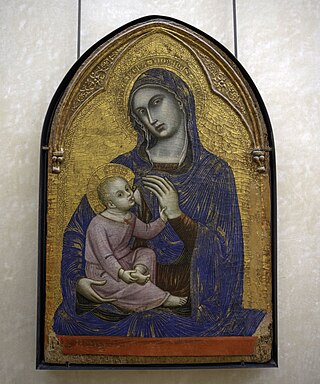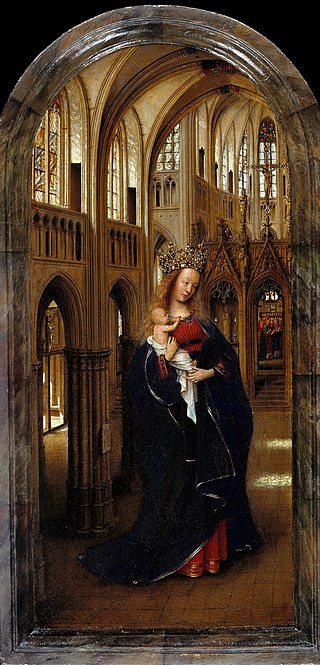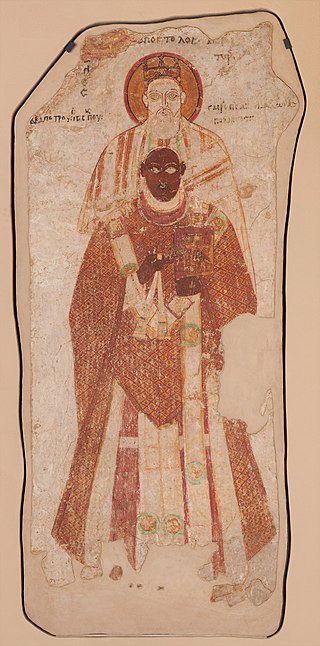
In art, a Madonna is a representation of Mary, either alone or with her child Jesus. These images are central icons for both the Catholic and Orthodox churches. The word is from Italian ma donna 'my lady' (archaic). The Madonna and Child type is very prevalent in Christian iconography, divided into many traditional subtypes especially in Eastern Orthodox iconography, often known after the location of a notable icon of the type, such as the Theotokos of Vladimir, Agiosoritissa, Blachernitissa, etc., or descriptive of the depicted posture, as in Hodegetria, Eleusa, etc.

Kazimierz Józef Marian Michałowski was a Polish archaeologist and Egyptologist, art historian, member of the Polish Academy of Sciences, professor ordinarius of the University of Warsaw as well as the founder of the Polish Centre of Mediterranean Archaeology. He coined the term "Nubiology" to refer to the study of ancient Nubia.

The Bachkovo Monastery of the Dormition of the Theotokos, archaically the Petritsoni Monastery or Monastery of the Mother of God Petritzonitissa is a major Eastern Orthodox monastery in Southern Bulgaria. It is located on the right bank of the Chepelare River, 189 km from Sofia and 10 km south of Asenovgrad, and is directly subordinate to the Holy Synod of the Bulgarian Orthodox Church. The monastery is known and appreciated for the unique combination of Byzantine, Georgian and Bulgarian culture, united by the common faith.

Salus Populi Romani is a Catholic title associated with the venerated image of the Blessed Virgin Mary in Rome. This Byzantine icon of the Madonna and Child Jesus holding a Gospel book on a gold ground, now heavily overpainted, is kept in the Borghese (Pauline) Chapel of the Basilica of Saint Mary Major. Pope Francis has constructed a burial vault near the icon, intended to be his final resting place.

Faras was a major city in Lower Nubia. The site of the city, on the border between modern Egypt and Sudan at Wadi Halfa Salient, was flooded by Lake Nasser in the 1960s and is now permanently underwater. Before this flooding, extensive archaeological work was conducted by a Polish archaeological team led by professor Kazimierz Michałowski.

The Warsaw National Museum, also known as the National Museum in Warsaw, is a national museum in Warsaw, one of the largest museums in Poland and the largest in the capital. It comprises a rich collection of ancient art, counting about 11,000 pieces, an extensive gallery of Polish painting since the 16th century and a collection of foreign painting including some paintings from Adolf Hitler's private collection, ceded to the museum by the American authorities in post-war Germany. The museum is also home to numismatic collections, a gallery of applied arts and a department of oriental art, with the largest collection of Chinese art in Poland, comprising some 5,000 objects.

Tadeusz Żukotyński was a Polish count, professor, and painter.

The Church of the Val-de-Grâce is a Roman Catholic church in the 5th arrondissement of Paris. The church was built as part of a royal abbey by Anne of Austria, the Queen of France, to celebrate the birth of her son, Louis XIV in 1638. Construction began in 1645 under the direction of architect François Mansart and was completed in 1665 by Gabriel Le Duc. The abbey and church were turned into a hospital during the French Revolution and then became part of the Val-de-Grâce Hospital, which closed in 1979. The church is attached to the diocese of the French military and is open to visitors at specified hours. Its dome is a landmark in the skyline of Paris.

The Nursing Madonna, Virgo Lactans, or Madonna Lactans, is an iconography of the Madonna and Child in which the Virgin Mary is shown breastfeeding the infant Jesus. In Italian it is called the Madonna del Latte. It was a common type in painting until the change in atmosphere after the Council of Trent, in which it was rather discouraged by the church, at least in public contexts, on grounds of propriety.

Madonna in the Church is a small oil panel by the early Netherlandish painter Jan van Eyck. Probably executed between c. 1438–1440, it depicts the Virgin Mary holding the Child Jesus in a Gothic cathedral. Mary is presented as Queen of Heaven wearing a jewel-studded crown, cradling a playful child Christ who gazes at her and grips the neckline of her red dress in a manner that recalls the 13th-century Byzantine tradition of the Eleusa icon. Tracery in the arch at the rear of the nave contains wooden carvings depicting episodes from Mary's life, while a faux bois sculpture in a niche shows her holding the child in a similar pose. Erwin Panofsky sees the painting composed as if the main figures in the panel are intended to be the sculptures come to life. In a doorway to the right, two angels sing psalms from a hymn book. Like other Byzantine depictions of the Madonna, van Eyck depicts a monumental Mary, unrealistically large compared to her surroundings. The panel contains closely observed beams of light flooding through the cathedral's windows. It illuminates the interior before culminating in two pools on the floor. The light has symbolic significance, alluding simultaneously to Mary's virginal purity and God's ethereal presence.

Waleria Tarnowska was a Polish patron of the arts and painter in her own right, known for miniatures, numerous portraits, religious paintings and drawings.

The Plourin-lès-Morlaix Parish close is located at Plourin-lès-Morlaix in the arrondissement of Morlaix in Brittany in north-western France. The Enclos paroissial comprises the Notre-Dame church, a cemetery, ossuary and retaining wall. The church is a listed historical monument since 1932.

The Battle of Orsha is a painting of the Battle of Orsha, which was fought on September 8, 1514 between the allied forces of the Grand Duchy of Lithuania and the Kingdom of Poland against the Vasili III's army of the Grand Duchy of Moscow (left) as part of the Muscovite–Lithuanian Wars.

The Barnovschi Church is a Romanian Orthodox church located at 26 Ghica Vodă Street in Iași, Romania. It is dedicated to the Dormition of the Mother of God and to Saints Joachim and Anna.

Bishop Petros with Saint Peter the Apostle is a Nubian Christian wall painting from the last quarter of the 10th century. Made with tempera on silt plaster using an al secco fresco technique, it depicts Petros, the bishop of Faras between 974 and 997. The anonymous work was discovered in the ruins of Faras Cathedral, an important religious centre of Nubia, in modern Sudan. Rescued from flooding when Lake Nasser was created, since 1964 it is part of the Faras Gallery of the National Museum in Warsaw.
Stefan Karol Jakobielski is a Polish historian, archaeologist, philologist, epigraphist. One of the pioneers of nubiology. He participated in archaeological research in Faras, Tell Atrib, Palmyra, Deir el-Bahari and Qasr Ibrim; directed the archaeological works at Old Dongola.

The Professor Kazimierz Michałowski Faras Gallery at the National Museum in Warsaw is a permanent gallery at the National Museum in Warsaw, presenting Nubian early Christian art. The Gallery features a unique collection of wall paintings and architectural elements from the Faras Cathedral, discovered by an archeological expedition led by Professor Kazimierz Michałowski.

Feliks Michał Wygrzywalski was a Polish painter remembered primarily for his Orientalist scenes and portraits. He also created a significant number of nudes. His son, Feliks Kazimierz Wygrzywalski, was also a painter.

Portrait of Zofia Potocka is an oil on canvas painting by German artist Franz Xaver Winterhalter, created in 1870. It is located in the National Museum, in Warsaw.

The Tregist village chapel, also known as the Ortskapelle Tregist or the Chapel of Mary, Untier of Knots, is a Roman Catholic chapel located in the municipality of Bärnbach in western Styria. The chapel, dedicated to Holy Mary, is part of the Voitsberg parish and thus belongs to the Voitsberg pastoral area in the Styrian central region of the Graz-Seckau diocese.



















